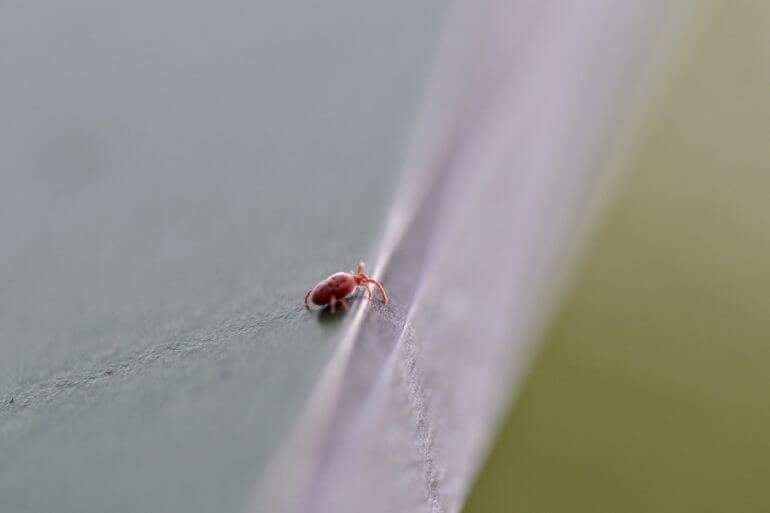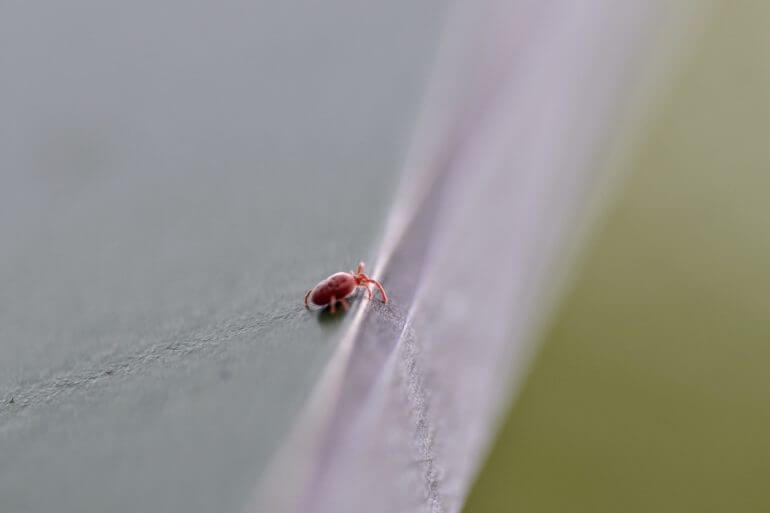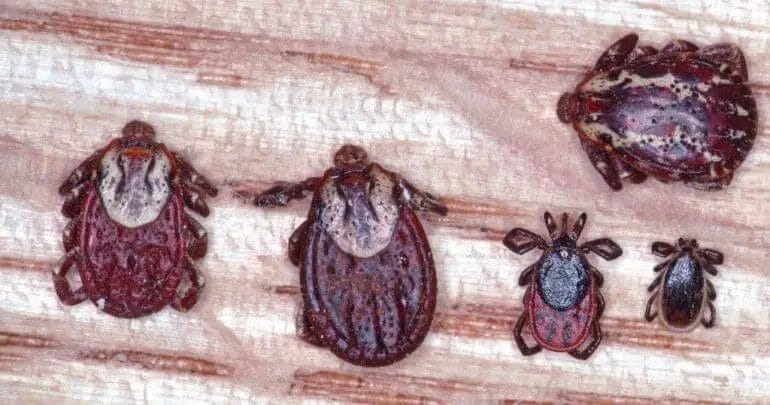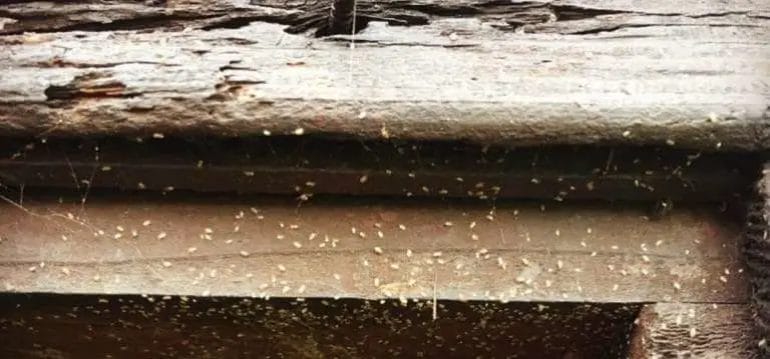Wood mites can be a nuisance, but there are effective ways to get rid of them. These tiny pests are not harmful to humans, but they can damage and infest wooden furniture, floors, and other surfaces.
To eliminate wood mites, start by thoroughly cleaning and vacuuming the affected areas to remove any dust or debris. Next, apply a targeted pesticide or insecticide specifically designed for mites. Additionally, consider using a dehumidifier to reduce moisture levels, as wood mites thrive in damp environments.

Regularly inspect and maintain your wooden surfaces to prevent future infestations. By taking these steps, you can successfully eliminate wood mites and protect your wooden belongings.

Effective Chemical Treatments for Wood Mite Infestations
Wood mites are tiny pests that can cause significant damage to wooden structures and furniture. If you’ve discovered a wood mite infestation, it’s crucial to take immediate action to prevent further damage. One of the most effective methods of controlling wood mites is through the use of chemical treatments. In this section, we will explore some of the most commonly used and effective chemical treatments for wood mite infestations.
1. Insecticidal Sprays
Insecticidal sprays are a popular and effective treatment option for wood mite infestations. These sprays contain chemicals that target and kill wood mites upon contact. When applying an insecticidal spray, it’s important to thoroughly cover the affected areas, ensuring that all surfaces are treated. Follow the instructions provided by the manufacturer and use personal protective equipment, such as gloves and a mask, during application.
It’s worth noting that not all insecticidal sprays are suitable for use on wood surfaces. Some sprays may contain chemicals that can damage or stain the wood. Therefore, it’s essential to choose a spray specifically labeled for use on wood mites and wooden surfaces.
2. Wood Preservatives
Wood preservatives are another effective option for treating wood mite infestations. These products work by penetrating the wood and killing any existing mites or their eggs. Additionally, wood preservatives provide long-term protection against future infestations.
When selecting a wood preservative, opt for a product that is designed specifically for treating wood mites. These preservatives often contain chemicals such as permethrin or cypermethrin, which are highly effective against wood mites. Follow the manufacturer’s instructions carefully for application and ensure that the treated wood is allowed to dry thoroughly before use.
3. Fumigation
In cases of severe wood mite infestations, fumigation may be necessary. Fumigation involves the use of chemicals in gaseous form to eliminate pests. This method is typically carried out by professionals and requires the affected wooden items or structures to be enclosed in a sealed area.
During fumigation, the space is filled with a fumigant gas, which penetrates the wood and kills the mites. The area is then ventilated to remove any remaining gas before it is considered safe for human occupation. Fumigation can be highly effective in eradicating wood mite infestations, but it should only be performed by trained professionals due to the potential hazards associated with the chemicals used.
4. Borate Treatments
Borate treatments are commonly used for the prevention and control of wood-boring insects, including wood mites. Borate is a naturally occurring mineral that is highly toxic to pests but safe for humans and pets when used correctly.
Borate treatments are typically applied as a liquid or gel directly onto the surface of the infested wood. The borate penetrates the wood, killing any existing mites and providing long-term protection against future infestations. It’s important to note that borate treatments are most effective as a preventive measure or in the early stages of an infestation.
5. Professional Pest Control Services
If you’re dealing with a severe or persistent wood mite infestation, it may be necessary to seek the assistance of professional pest control services. These experts have the knowledge, experience, and access to specialized chemicals and equipment to effectively treat and eliminate wood mite infestations.
When hiring a professional pest control service, ensure that they have experience in dealing with wood mite infestations and are licensed to handle the specific chemicals required. Additionally, inquire about any follow-up treatments or maintenance plans to ensure long-term protection against wood mites.
Summary
Wood mite infestations can wreak havoc on wooden structures and furniture. When faced with a wood mite infestation, it’s crucial to take swift action to prevent further damage. Chemical treatments, such as insecticidal sprays, wood preservatives, fumigation, borate treatments, and professional pest control services, are effective methods for eradicating wood mites.
It’s important to choose the appropriate treatment method based on the severity of the infestation and the type of wood being treated. Follow the manufacturer’s instructions carefully for application and safety precautions. By utilizing these effective chemical treatments, you can successfully eliminate wood mites and protect your valuable wooden assets.

Tips for Preventing Wood Mite Infestations in Your Home
Wood mites are tiny pests that can cause significant damage to wooden furniture, flooring, and other wooden structures in your home. These microscopic creatures feed on wood particles and can quickly multiply, leading to infestations that are difficult to eradicate. To protect your home from wood mite infestations, follow these helpful tips:
1. Keep your home clean and clutter-free
Regularly clean your home, especially areas where wood is present. Vacuum carpets, rugs, and upholstery to remove dust and wood particles that may attract wood mites. Keep your home free of unnecessary clutter, as it provides hiding places for pests.
2. Maintain proper humidity levels
Wood mites thrive in environments with high humidity. To prevent infestations, ensure that your home’s humidity levels are between 30% and 50%. Use dehumidifiers in damp areas such as basements or bathrooms and fix any leaks or moisture issues promptly.
3. Inspect and treat wooden furniture
Regularly inspect your wooden furniture for any signs of wood mite activity. Look for small holes, sawdust-like debris, or tiny crawling pests. If you notice any infestation, isolate the affected furniture and treat it with appropriate wood mite repellents or contact professional pest control services for assistance.
4. Seal cracks and crevices
Wood mites can enter your home through tiny cracks and crevices. Seal any gaps in windows, doors, and walls using caulk or weatherstripping. Pay special attention to areas where wood is in contact with the exterior of your home.
5. Store firewood properly
If you have firewood stored indoors, make sure to keep it off the ground and away from walls. Wood mites can easily transfer from firewood to your home, leading to an infestation. Store firewood in a dry area and inspect it thoroughly before bringing it inside.
6. Regularly inspect your wooden structures
Periodically inspect wooden structures such as decks, fences, and sheds for signs of wood mite infestation. Look for discolored or damaged wood, as well as small holes or tunnels. If you suspect an infestation, take immediate action to prevent further damage.
7. Use preventive treatments
Consider using preventive treatments such as wood mite repellents or insecticides that are specifically designed for wood mites. Apply these treatments to vulnerable areas or surfaces to create a barrier against infestations.
8. Seek professional help
If you’re dealing with a severe wood mite infestation or if your preventive measures haven’t been effective, it’s best to seek professional help. Pest control experts have the knowledge and tools to identify and eliminate wood mite infestations effectively.
Summary
Wood mite infestations can be a nuisance and cause damage to your home’s wooden structures. By following these tips, you can prevent wood mites from infesting your home and protect your valuable wooden furniture and flooring. Keep your home clean and clutter-free, maintain proper humidity levels, inspect and treat wooden furniture, seal cracks and crevices, store firewood properly, regularly inspect wooden structures, use preventive treatments, and seek professional help when needed. By implementing these preventive measures, you can ensure a wood mite-free home environment.

How to Safely Dispose of Infested Wood to Eliminate Mites
If you have discovered mites infesting your wood, it is important to take immediate action to prevent the infestation from spreading. Proper disposal of the infested wood is crucial to ensure the complete eradication of mites. In this section, we will outline the steps you can follow to safely dispose of infested wood and eliminate mite infestations.
1. Identify the Infested Wood
The first step in safely disposing of infested wood is to identify which pieces of wood are affected by mites. Inspect the wood carefully for signs of mite infestation, such as tiny holes, sawdust-like frass, or the presence of live mites.
2. Separate Infested Wood from Uninfested Wood
Once you have identified the infested wood, it is important to separate it from any uninfested wood to prevent the mites from spreading. Place the infested wood in a designated area away from other wood materials.
3. Seal the Infested Wood
To contain the mites and prevent them from escaping, it is essential to seal the infested wood. Wrap the infested wood tightly in plastic sheets or tarps, ensuring that there are no gaps or openings. Use duct tape or heavy-duty plastic wraps to secure the wrapping.
4. Transport with Caution
When moving the wrapped infested wood, handle it with caution to avoid any accidental release of mites. If possible, use gloves and protective clothing to minimize direct contact. Be careful not to drop or damage the wrapped wood during transportation.
5. Choose the Disposal Method
There are several safe disposal methods you can choose from to eliminate mites effectively:
- Burning: If local regulations permit, burning the infested wood is an effective way to eliminate mites. Ensure that you follow fire safety protocols and dispose of the ashes properly.
- Landfill: Check with your local waste management facility if they accept infested wood. Wrap the sealed infested wood in an additional layer of plastic before disposing of it in the landfill.
- Professional Pest Control Services: If you are unsure about handling the disposal yourself, consider hiring a professional pest control service. They have the expertise and proper disposal methods to safely eliminate the infested wood.
6. Clean the Surrounding Area
After disposing of the infested wood, it is essential to clean the surrounding area thoroughly. Vacuum any dust or debris that may have accumulated and disinfect the area to kill any remaining mites or eggs.
7. Monitor for Reinfestation
Even after safely disposing of the infested wood, it is important to monitor the area for any signs of reinfestation. Keep a close eye on nearby wood materials and take preventive measures to avoid future mite infestations.
In summary, safely disposing of infested wood is crucial to eliminate mite infestations effectively. By following the steps outlined above, you can ensure the complete eradication of mites and prevent their spread to other wood materials.
Common Signs and Symptoms of a Wood Mite Infestation
Wood mites are tiny arachnids that can infest wooden structures, furniture, and even firewood. While they are generally harmless to humans, a wood mite infestation can be quite annoying and unsightly. It is important to be aware of the common signs and symptoms of a wood mite infestation so that you can take appropriate action to control and eliminate them. Here are some telltale signs to look out for:
1. Itchy Skin
One of the most common symptoms of a wood mite infestation is itching. Wood mites have tiny bristly hairs that can cause irritation and itching when they come into contact with human skin. If you notice persistent itching, especially after being in close proximity to wooden surfaces, it could be a sign of a wood mite infestation.
2. Visible Mites
In severe infestations, you may be able to see the wood mites themselves. These pests are usually very small, about 1mm in size, and are often pale or translucent in color. They can be found crawling on wooden surfaces, furniture, or even on the walls near infested areas. If you spot any tiny moving creatures that resemble mites, it is likely that you have a wood mite infestation.
3. Wood Dust or Powder
Wood mites feed on fungal mold that grows on damp or decaying wood. As they consume the mold, they leave behind fine wood dust or powder. If you notice a powdery substance on or around wooden surfaces, it could be a sign of wood mite activity. This is especially common in areas with high humidity or moisture, as damp conditions promote mold growth.
4. Damage to Wood
Wood mites do not feed directly on the wood itself, but they can indirectly cause damage by contributing to the growth of mold. Over time, this mold can weaken and decay the wood, leading to structural damage. If you notice signs of wood decay, such as soft or crumbling wood, it could be a result of a wood mite infestation.
5. Allergic Reactions
Some individuals may have allergic reactions to wood mite bites or the substances they produce. If you experience symptoms such as redness, swelling, or a rash after being in contact with wooden surfaces, it could be an allergic reaction to wood mites. In such cases, it is essential to seek medical advice for proper diagnosis and treatment.
If you observe any of these signs and symptoms, it is important to address the wood mite infestation promptly. Start by identifying and eliminating the source of moisture that is promoting mold growth. This may involve fixing leaks, improving ventilation, or reducing humidity levels. Additionally, clean and disinfect the affected areas using appropriate fungicides or insecticides, following the instructions provided by the manufacturer.
In summary, wood mite infestations can cause itching, visible mites, wood dust or powder, damage to wood, and allergic reactions. If you suspect a wood mite infestation, take the necessary steps to control and eliminate these pests for a healthier and pest-free environment.
FAQs
1. How can I get rid of wood mites?
To eliminate wood mites, start by removing any infested wood or furniture. Vacuum the area thoroughly and apply a residual insecticide specifically designed for mites. Keep the area clean and dry to discourage further infestations. Consider consulting a pest control professional for severe infestations.
2. What are some natural methods to control wood mites?
You can use natural remedies like neem oil, tea tree oil, or cedar oil to repel wood mites. Regularly cleaning and dusting the affected area can also help prevent and control infestations. Additionally, maintaining low humidity levels and proper ventilation can deter wood mites.
3. Can wood mites cause harm to humans?
Wood mites are generally harmless to humans and don’t cause any direct harm. However, their presence can indicate a larger pest problem, such as wood decay or other infestations. It’s important to address the underlying issue and eliminate the wood mites to prevent further damage.
Conclusion
In conclusion, getting rid of wood mites can be a challenging task, but with the right approach, it is definitely possible to eliminate them from your home or furniture. Remember to start by identifying the source of the infestation and taking necessary preventive measures to avoid their return. Regularly cleaning and dusting your wooden surfaces will help prevent the accumulation of mites. Additionally, using natural remedies like neem oil or diatomaceous earth can be effective in getting rid of wood mites without the use of harmful chemicals. If the infestation persists, it is advisable to seek professional help to ensure thorough eradication. Don’t let these tiny pests take over your home – take action and reclaim your space today!